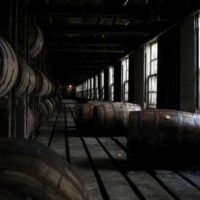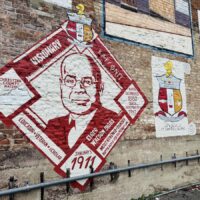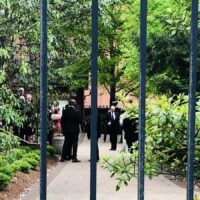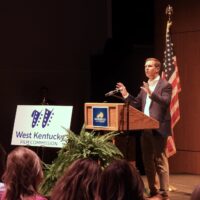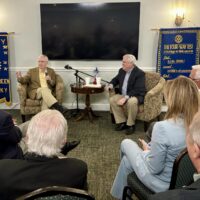On Feb. 5, 1886, the Semi-Weekly South Kentuckian reported the following:
“Snow-balling is a rather dangerous pastime [sic] and should not be indulged in by boys even, but we have noticed a number of businessmen of mature ages and dignified bearing taking a hand in the numerous battles that have made it rather unpleasant to pass up and down Main street for the last two or three days.”
The street is the same, but the picture is wildly different. Last month in this column, we were transported to a peaceful moment on Main Street at Christmas in 1932. Today, our scene takes us further back in time but barely a block from where we started. Our gaze has turned to the north. I feel like I could reach down and form a perfect snowball. The photographer releases the shutter …
CLICK!
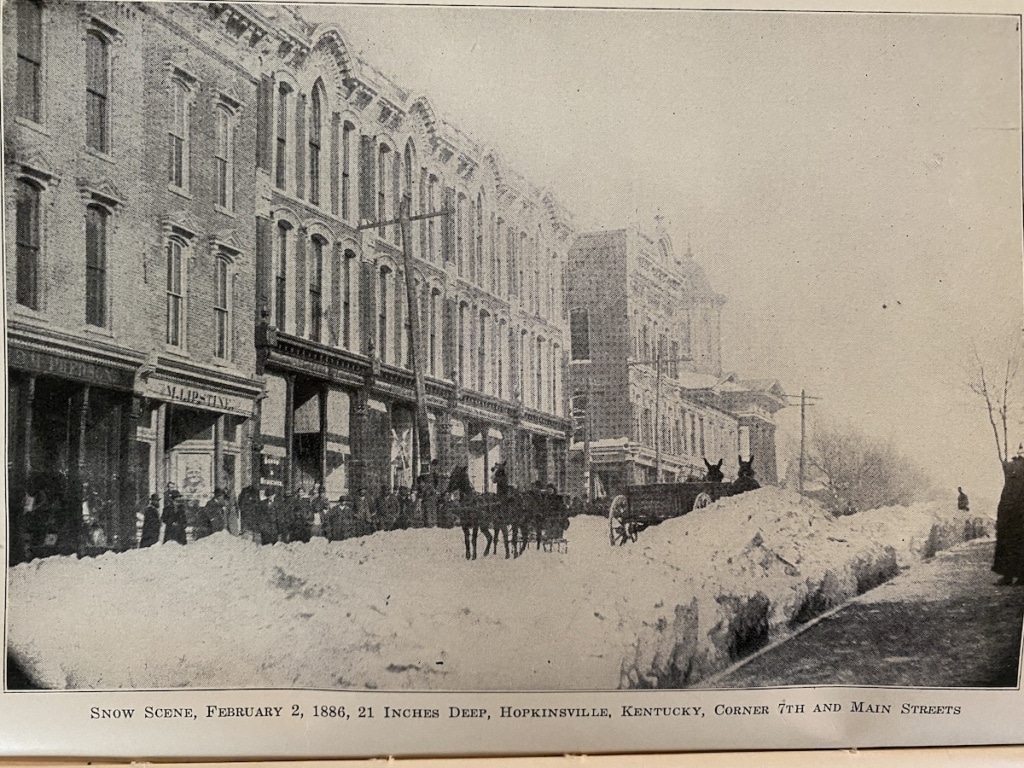
A monumental moment is captured.
The year was 1886, and the photographer was Clarence Anderson. He has set up his camera on South Main Street to document one of the biggest snowfalls in this community’s history. On Feb. 2, 1886, a virtual blizzard dumped upwards of 21 inches of snow on Hopkinsville and Christian County. Contemporary reports indicate some drifts reached from 2 to 6 feet deep in places. The South Kentuckian claimed that “there has never been anything like it in this latitude and it is doubtful if we will see the like again during the present generation.”
According to newspapers, E. L. Foulks, a coal dealer and former photographer, had a street plow driven up several streets allowing for the crowd, a wagon, and a sleigh to make their way into our view. While the wagon is left unattended, the sleigh holds a couple who are bundled up for the ride. Based on their ears pointed at high alert, the horses and mules seem to wish that they were bundled up, too!
As we look up Main Street from Eighth Street and past the intersection of Seventh Street, we are greeted with a familiar streetscape. All of the buildings on the west side of the street still stand today. At the top of the hill, we see the Christian County Courthouse. The fourth courthouse to grace the site, this beauty was constructed in 1869 after the previous one was burned by Confederate troops near the end of the Civil War. Designed by J.K. Frick, the courthouse is shown here with its original cupola. The wooden dome was replaced with a more imposing version in 1903. Some may remember it before it was removed for fear of its weight compromising the roof in 1960.

Before we cross Seventh Street, I want to point out a feature of this picture that didn’t stand out to me immediately: the tall wooden poles along the streets. With the look of today’s telephone and electric poles, they seem absolutely natural … until I remembered the date of the picture. These are, in fact, telegraph poles. The first telegraph operator, known then as a “manipulator of the wires,” made his debut in Hopkinsville in 1858. At the time of this photograph, the Western Union Telegraph Office occupied a building barely out of our view and across Main Street from the courthouse.
As we travel past the E.B. Bassett building and across Seventh Street, we encounter Beard’s Block, as it was listed on the Sanborn Fire Insurance Map of the same year as the photograph. Aside from the courthouse, every building in this picture was constructed between 1883 and 1885. A huge fire, the biggest in the city’s history, consumed seven city blocks on Oct. 25, 1882. Buildings along this block of Main Street were rebuilt shortly thereafter, resulting in the view we see in this photograph — and still today.
The storefronts in view provided a variety of retail outlets. A dry goods store occupied the corner of Seventh Street, and H.B. Garner operated the City Drug Store three bays to the south. Located at No. 9 Main Street, M. Lipstine’s sold “Gents’ Furnishing Goods,” including shirts, cuffs, handkerchiefs, suspenders, and underwear available in “white or colored, very fancy.” Born in the Bavarian region of Germany, Maximillian Lipstine settled in Hopkinsville around 1856 and is listed as a “dealer in wool” in the 1880 census for Christian County. Lipstine died in 1891 and was buried in Judah Touro Cemetery in Cincinnati, Ohio.
Barely in view at No. 11 Main Street is J.D. McPherson’s, a music store that sold fine pianos and organs. The shop had been open about two years and had just moved into its location in Beard’s Block at the beginning of the year. Bad news for the music business, though. The South Kentuckian reported in April 1886 that McPherson was closing his shop and selling everything to pay off his creditors. According to the newspaper, his shop was the only one of its kind in the city, and “his failure shows that such a store cannot be made a success in cities as small as Hopkinsville.”
Now, a tragic aside. A tragic snow-balling aside, that is. Although outside of the camera lens from which we view, this monumental snow event led to the untimely, and ultimately accidental, death of a young man.
A week after the snowfall, a group of guys, including John W. Breathitt Jr., who owned a store across the street, were throwing snowballs over the 100-foot tower of the old Methodist Church on the corner of Ninth and Clay streets. As a couple of passers-by approached, the guys joked about turning it into an all-out snowball fight. Wilbur Wilson, with a target gun in hand, threatened to shoot anyone who hit him with one of the frozen projectiles. Two brave souls hurled snowballs — nearly missing his head. True to his word, Wilson fired a single shot, striking Breathitt in the gut.
After languishing for a number of days, the 25-year old businessman died from his wound. A gunshot wound — as the result of a snowball. (Nearly 78 years later, Breathitt’s older brother’s grandson, Edward T. “Ned” Breathitt, of Hopkinsville, became the governor of Kentucky.)
Later that year, Wilson was found guilty of involuntary manslaughter. He was sentenced to three months in the county jail and fined $250, according to a story in the Sept. 28, 1886, edition of Semi-Weekly South Kentuckian.
As we bring our focus back on the image, we are reminded of the generations before us who lived and weathered storms of all kinds on the streets we still travel. And never to get in a snowball fight with a man holding a gun.
(This article was updated on Jan. 18, 2022, to include details about Wilbur Wilson’s conviction.)
Alissa Keller is the executive director of the Museums of Historic Hopkinsville-Christian County. She’s a graduate of Centre College with degrees in history and English and of Clemson University/College of Charleston with a master’s degree in historic preservation. She serves on the Kentucky Historical Society and the Kentucky Museum and Heritage Alliance boards.
